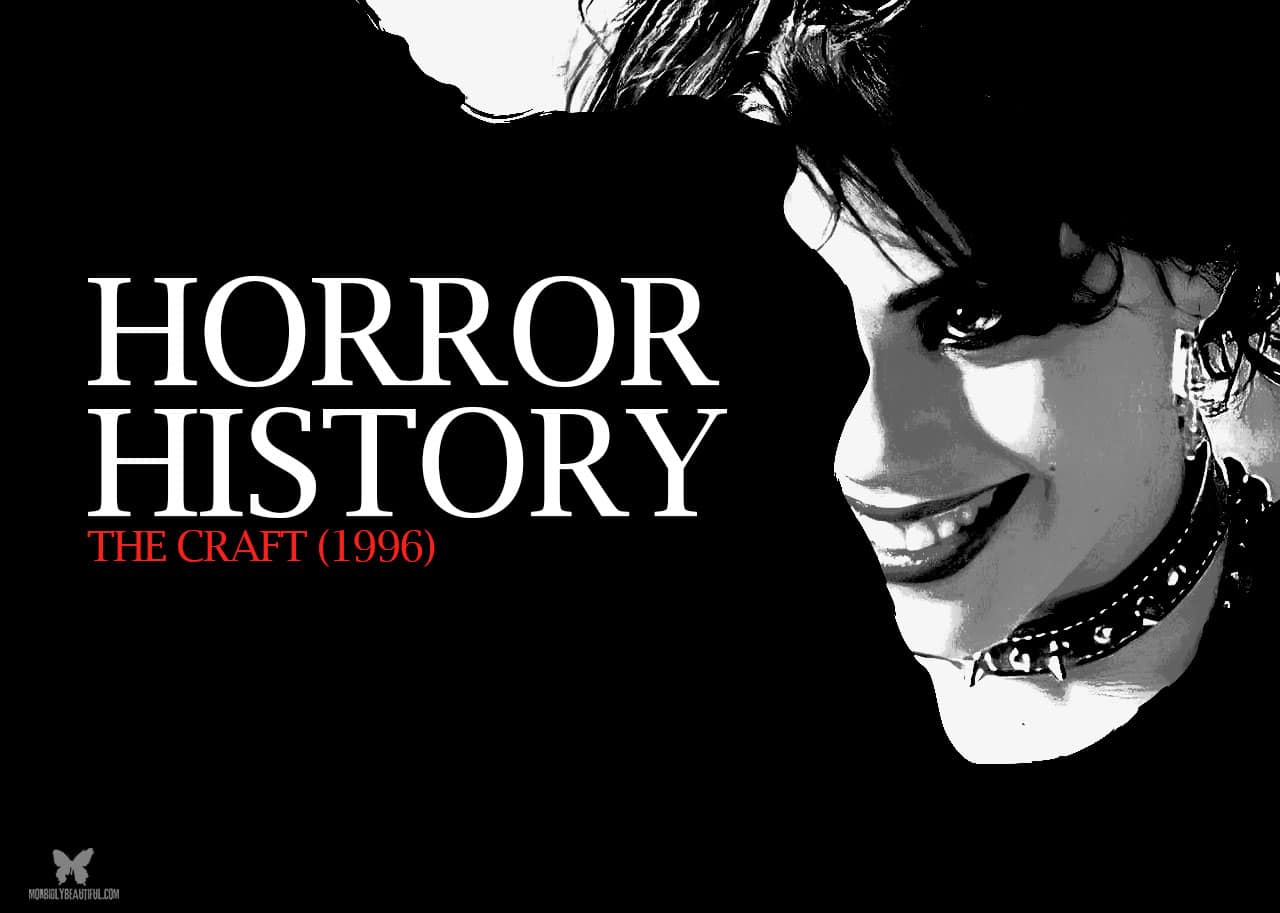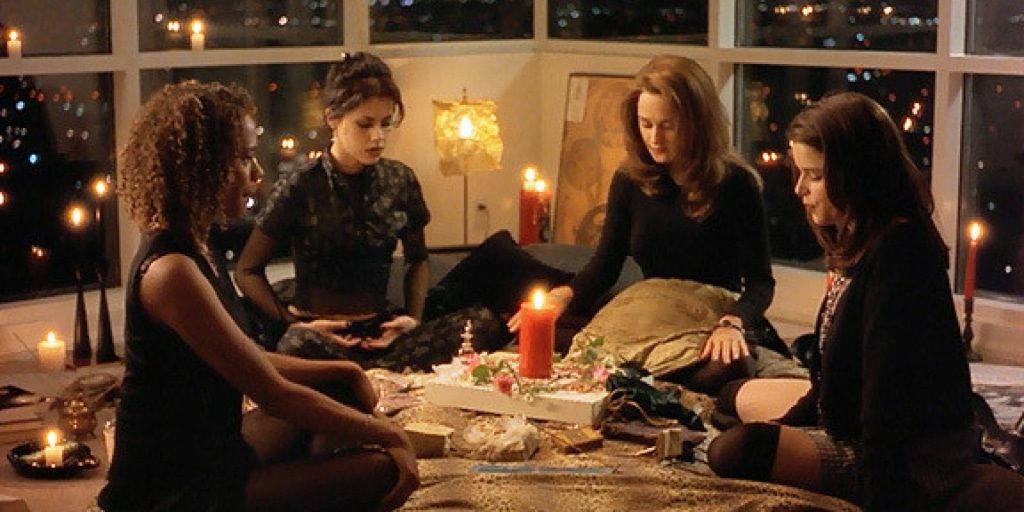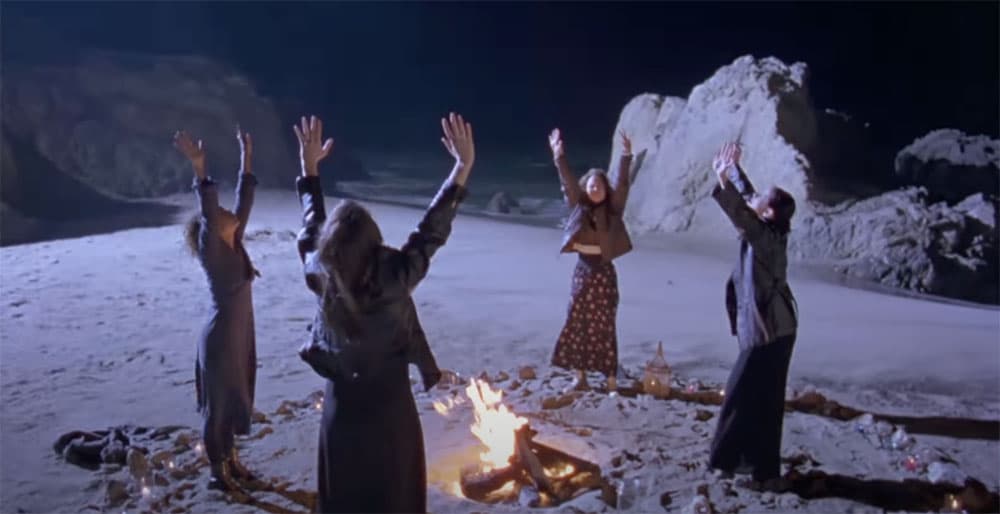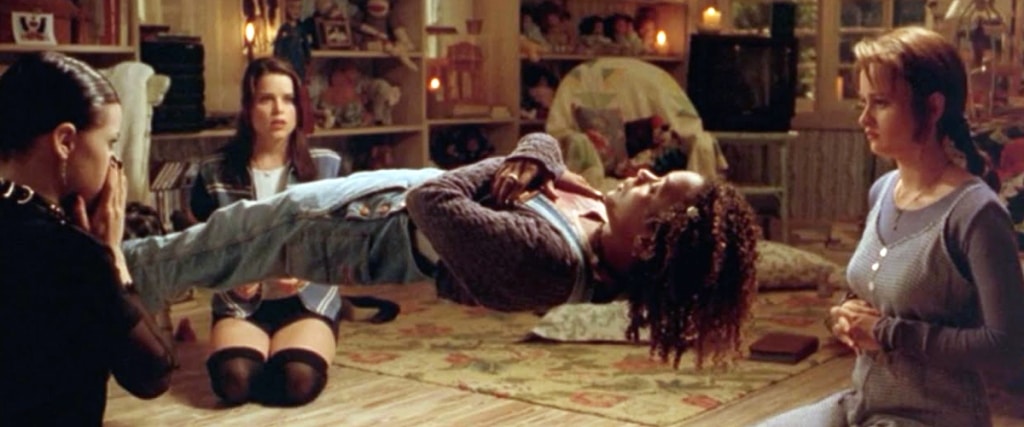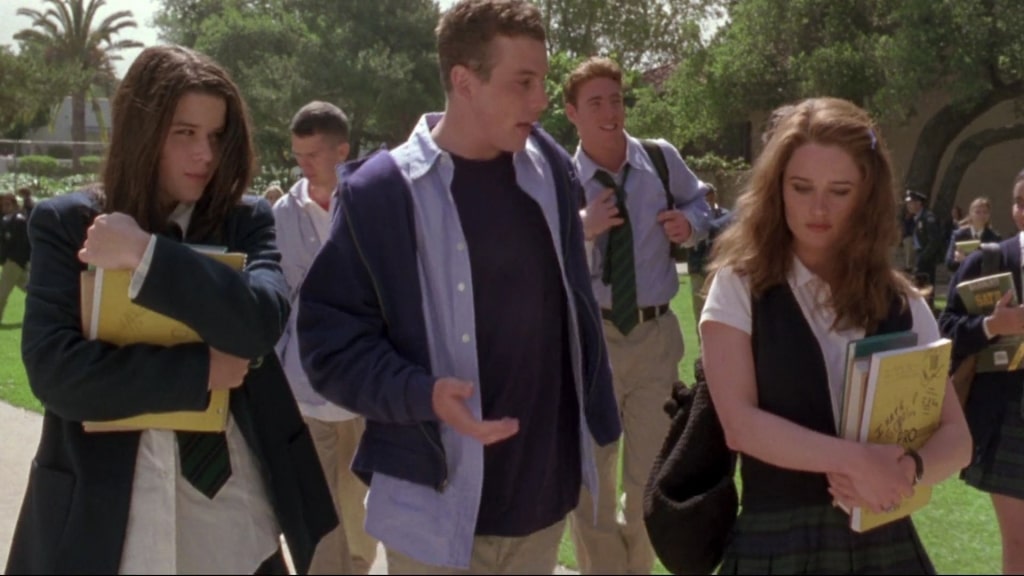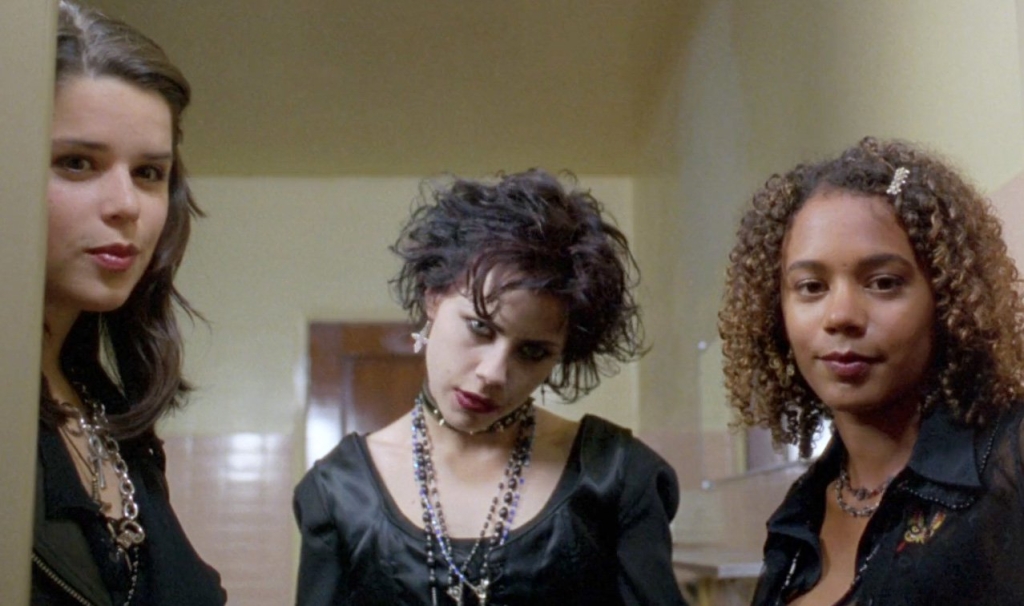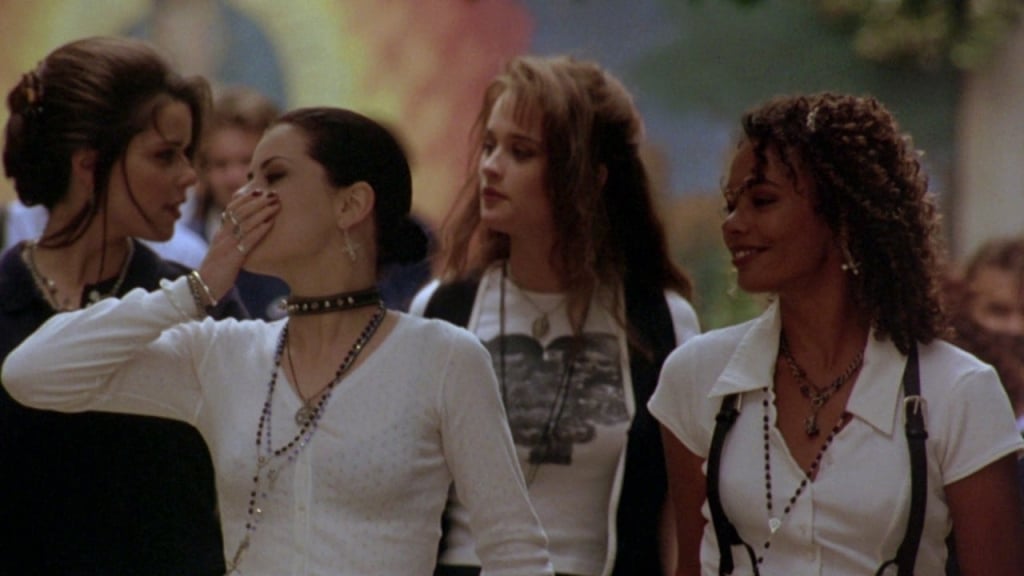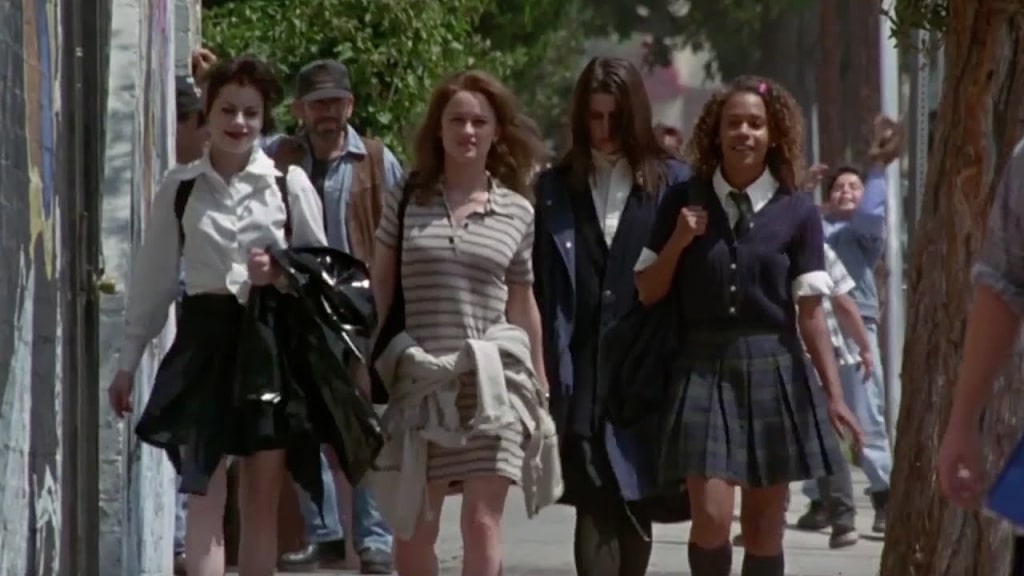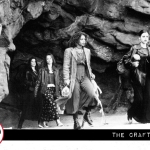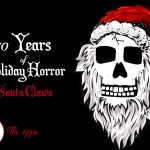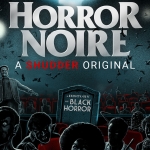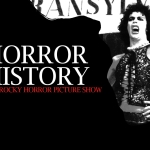“The Craft” remains influential as one of the first movies to focus primarily on young women as the primary protagonists and antagonists.
Sarah (Robin Tunney) moves into a new house with her father and stepmother. Her mother died during childbirth, which is something Sarah has never come to terms with. Sarah has a history of depression and suicide.
There’s something else about Sarah; she has extrasensory abilities. She attracts the interest of a coven of witches at school: Nancy (Fairuza Balk), Bonnie (Neve Campbell), and Rochelle (Rachel True). Sarah joins their circle and helps them unlock and unleash their power — with dangerous consequences.
The Craft is an iconic film that tells the story of four teen outcasts.
They’re not outcasts trying to be popular. Instead, they explore witchcraft and magic to empower themselves. Sure, they decide to tap into their newfound abilities to get revenge on bullies. The temptation would be too great not to, right? The story takes another twist, illustrating how power corrupts.
The Craft was a surprise hit upon its release on May 3, 1996.
Produced on a $15 million budget, the film earned $6.7 million on its opening weekend and $55.6 million worldwide. Reviews were mixed. Praised for Balk’s performance and the film’s feminist message, the film was criticized for being too cliched. The Craft received nominations for Best Horror Film and Best Supporting Actress for Balk for the Saturn Awards. Balk and Tunney won an MTV Movie Award for Best Fight.
The film spawned one sequel released on October 28, 2020.
It all started with director Andrew Fleming’s fascination with witchcraft.
Fleming has a history of making films with female protagonists, including Bad Dreams, Nancy Drew, and Dick. He wanted to make a movie about outcasts who dabble in witchcraft and empower themselves with supernatural abilities.
Peter Filardi wrote the screenplay, doing a deep dive into the Wicca religion to enhance the story.
Fleming also hired a real-life Wiccan priestess, Pat Devin, as a consultant. He wanted to ensure that the chants and spells in the film were accurate. To further ensure accuracy, Devin ran all of the film’s spells and incantations past numerous covens.
During the scene on the beach, Balk as Nancy reads from the book Invocation of the Spirit. The incantation comes from The Book of Ceremonial Magic by Arthur Edward Waite, a real-life occultist best known for being the co-creator of the Rider-Waite Tarot card deck.
Manon, the god whom the coven tries to invoke on the beach, is the only thing that is not authentic. Manon is a fictitious deity created for the film to avoid offending real-life religious groups.
Fleming told HuffPost, “The whole idea was to make up stuff because the god that they refer to in the movie is something that we made up — because it might have been offensive to people if we had used people’s real gods. We created our own.”
Many of the events in the film were inspired by events from Fleming’s life.
He based each of the four young women on young women he knew in high school and said that each represents an element: Sarah represents earth, Rochelle represents water, Bonnie represents air, and Nancy represents fire.
The famous “Light as a feather, stiff as a board” game was something Fleming’s sister played with her friends.
The scene with the beached sharks was another childhood experience Fleming had. Seeing beached sharks during a trip to the beach stayed with him and disturbed him so much that he included it in the film.
Lastly, the scene where Nancy is running red lights is based on a significant event Fleming experienced in college. A man he was riding around with was trying to time it so he could drive through the traffic lights when they were all green. In real life, the driver got into a head-on collision, which resulted in Fleming’s head hitting the windshield.
The Craft took nine months to cast.
Eighty-five actresses auditioned, including Angelina Jolie and Alicia Silverstone.
Rachel True was the first cast as Rochelle. In the script, Rochelle was not African American, and her backstory was that she suffered from bulimia. Once True was cast, the story was changed to Rochelle dealing with racism at school.
Real-life Wiccan Fairuza Balk, who was cast as Nancy, also advised the producers. Balk was a child actress who previously starred in films with witchcraft themes, including Return to Oz (1985) and The Worst Witch (1986).
Robin Tunney was coming off her breakout performance in Empire Records (1995), and Neve Campbell was known for her role in the TV series Party of Five.
The cast also includes Skeet Ulrich, who co-starred with Campbell in Scream, released the same year as The Craft. Ulrich was the final member cast as principal photography began. Tunney suggested Ulrich for the role, but he wasn’t a well-known actor at the time. Finally, when they agreed to let him come in for a test read, Ulrich impressed the filmmakers and got the part.
Tunney was originally cast as Bonnie. Because of her “sincerity and empathy,” the filmmakers thought she’d be a better fit for Sarah. Tunney felt that she related more to Bonnie but was eventually persuaded to take the role of Sarah. Tunney also had to wear a wig since she shaved her head for her role in Empire Records. Craft costume designer Deborah Everton told HuffPost she liked the buzz cut, but the studio wanted Tunney to wear a wig.
At the start of filming, the cast received bags filled with candles, incense, and witchcraft books.
ScreenRant reported, “Campbell says that she started using the bags’ contents and felt ‘witchy,’ and when she listened to Pat Devin, the witchcraft consultant, she felt inspired.”
While the interiors were all sets, the outdoor scenes were shot in and around Los Angeles. A house in downtown Los Angeles served as Sarah’s family’s house. Not surprisingly, the filmmakers had difficulty finding a church that would let them shoot a film about witchcraft. They finally found one church that desperately needed money and agreed to it.
As for special effects, a green screen was used for the light as a feather, stiff as a board scene, as well as the scene where the coven flies through Sarah’s window and the scene with Nancy walking on water.
The scene where Nancy turns into Sarah was challenging to film. Each actress had to be filmed separately, matching each other’s movements exactly.
One of the most difficult scenes to shoot was the ritual on the beach during which the coven evokes Manon.
The park ranger advised the cast and crew that the tide would be low. However, the tide kept rushing in to ruin the shot whenever Balk would say her lines summoning Manon. “It was just this odd thing where when the girls started the incantations, the waves kind of came up. And at one point, a wave came and wiped the whole set out,” Fleming said.
A Wiccan consultant pointed out something interesting. While Manon is fictitious, the name sounds similar to Manannon, a god who is part of the Wiccan faith and is known as the God of the Sea. Therefore, the consultant believed the dialogue in the scene may have evoked Manannon.
The fight scene at the end used real snakes and cockroaches. Director Andrew Fleming told HuffPost that 10,000 snakes were used on set, which were kept lying around in buckets. Mostly, Tunney had to interact with the snakes. Fortunately, Tunney isn’t afraid of snakes.
The hallway fight scene between Nancy and Sarah was tricky also. The crew built the hallway set sideways and turned the camera on its side. The actors lay on the floor while things were dropped on them from above.
Given its subject matter and R rating, the film’s tremendous profitability surprised many.
Producers followed strict guidelines to secure a PG-13 rating, but The Motion Picture Association of America insisted on giving the film an R rating. The filmmakers were told the reason was that it was about young women practicing witchcraft.
Still, the film resonated with audiences, became an important part of the cultural landscape, and was considered highly influential for its authentic portrayal of teenage girls who practice witchcraft to gain power and improve their lives.
Of course, anything successful in pop culture is often copied, so it’s no surprise the film gave rise to many other interpretations of young witches in the media.
The television show Charmed is often assumed to be heavily inspired by The Craft. Andrew Fleming stated he had written a pilot for another TV series based on The Craft. His script was rejected, but one year later, Charmed aired. Note that Charmed uses a song from The Craft soundtrack, Love Spit Love’s cover of The Smiths’ How Soon is Now, which Fleming wanted as the main theme for the pilot he wrote. Tunney has also said many people mistakenly believe she was on Charmed.
Around the time of The Craft’s release, a similar independent movie, Little Witches, was released on home video. The film reportedly had the same look and similar soundtrack as The Craft, with basically the same story. The poster even depicted an actress who strongly resembles Fairuza Balk. Little Witches failed to make the same impression, with the Chicago Times calling it one of the worst movies of 1996.
The Craft has left an indelible mark on horror history. It’s unique for its time as one of the first movies to focus on young women as the main characters.
The story takes a refreshingly different approach in its depiction of witchcraft, presenting it from the perspective of the Wicca religion.
Since 1996, the media has offered many different interpretations of witchcraft, and films and shows centering around young women are not uncommon.
However, modern, nuanced depictions of witchcraft — including in shows like Broad City, Pen15, Charmed, and The Chilling Adventures of Sabrina — no doubt stem from Fleming and Filardi’s influence and respectufl approach to the material at a time when such a thing was not well-represented.


